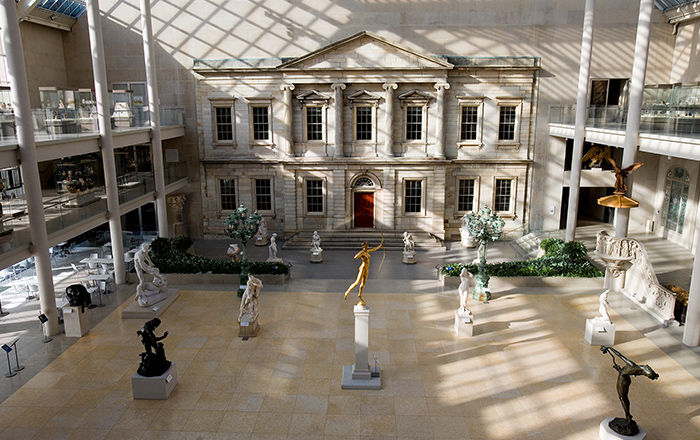Sampler
Ann Sayres American
Samplers made in the American colonies before 1740 are very rare. Ann Sayres’ meticulously worked sampler features three horizontal bands of alphabets at top. Beneath the alphabets there are seven bands of artfully stitched decorative motifs. The decorative patterns are separated from each other by a variety of different zig-zag borders. The patterns found in the central horizontal bands are typical of early Boston-area samplers, and the band of hexagonal shapes stitched in two shades of green at the center is found only in eighteenth-century needlework from Boston. However, other of the designs seen here have also been identified on earlier English precursors.
The repeated rows of geometric or stylized floral motifs were often copied from English and European needlework pattern books and engravings. These sources were advertised as early as 1706 in Boston newspapers. Early American sampler patterns also came to this country with émigré needlework teachers, who gained cachet by advertising themselves as “having recently arrived from London” or drawing designs from “Patterns from London.”
The design of the upper and lowercase letters was copied from alphabets published in penmanship schoolbooks, tradesmen journals and artisan manuals. A careful reading of the alphabets reveals they do not include the letters “J” and “U”. This was because, in the common writing of the day, “I” was used for “J” and “V” for “U”.
Band samplers were practice pieces for the young women, who were educated in preparation for marriage and running a household. They would initial their precious linens with the letters they learned on the sampler, and the band patterns might decorate the hems or sleeve ends of clothing they made for their families.
Ann Sayres’ vibrant band sampler is one of only three early eighteenth-century American samplers in The Met’s collection. (See also 1984.331.6 and 2010.356). As was common, the makers all inscribed their name and the year they worked the sampler. This sampler’s inscription reads: “Ann Sayres is my name and With my Needel [sic] I made the same. The Grass is Green, The Rose is Red. Here is my Sampler. When I am dead. 1739.” Following the verse, she lists seven sets of initials, all ending with the letter “S”, suggesting they represent her Sayres family members, most likely her parents and siblings. But despite the family’s initials, Ann Sayres’ genealogy has yet to be discovered, as “Sayres” was a common name at the time, and had several possible spellings.
This image cannot be enlarged, viewed at full screen, or downloaded.

